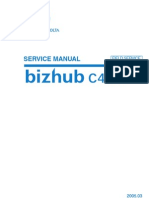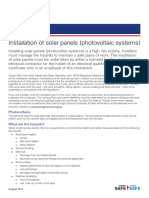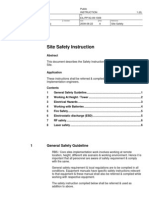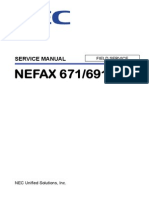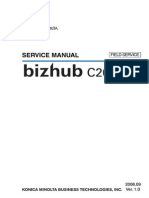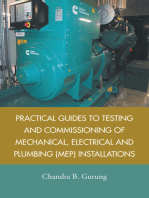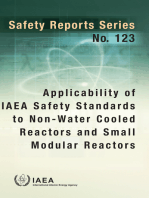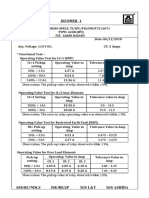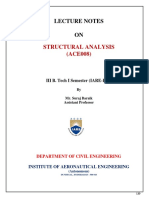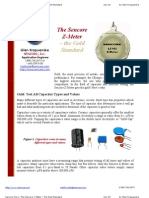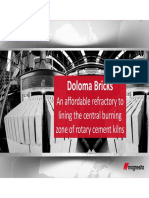Unit 3
Unit 3
Uploaded by
kunal onkarCopyright:
Available Formats
Unit 3
Unit 3
Uploaded by
kunal onkarOriginal Title
Copyright
Available Formats
Share this document
Did you find this document useful?
Is this content inappropriate?
Copyright:
Available Formats
Unit 3
Unit 3
Uploaded by
kunal onkarCopyright:
Available Formats
UNIT III:
SAFETY DURING INSTALLATION, TESTING AND COMMISSIONING, OPERATION AND
MAINTENANCE
Preliminary preparations - safe sequence- risk of plant and equipment - safety documentation - field
quality and safety - personal protective equipment - safety clearance notice - safety precautions -
safeguards for operators - safety.
OBJECTIVES OF THIS UNIT
The Installation (Erection) work is a major part of the project construction. Safety of personnel during
installation is very important.
Good Quality of Civil Work and Good Quality of Equipment, Good quality of erection tools and tackles
and Trained Man Power are the prerequisites for Electrical safety during erection.
Supervisors and workers must be familiar with the safety rules and precautions to be taken in general
and for installing particular plant equipment.
So the objective of this unit is to make students familiar that Safety can be assured through good
planning, adequate protective equipment
PRELIMINARY PREPARATIONS
• The preliminary preparations before commencing installation include:
• -Preparation of L1, L2 and L3 bar charts of Erection and Commissioning activities. L1 for
Erection includes following activities:
• -Finalising subcontracts for Erection.
• -Receiving and study of Plant Documentation and Equipment Documentation, at site. Establish
system of As built drawings and installation inspection records. Study of Drawings and
Manuals.
• Arranging tools, tackles, transportation, handling facility. Receiving and storage of Equipment.
• -Arranging Safety Facilities and First Aid Facility. -Training of personnel.
• -Arranging formats and registers for records.
ELECTRICAL SAFETY & STANDARDS |Prepared By. Prof. Kunal A. Onkar
Q. What are L1, L2, L3 charts?
L1, L2, L3 BAR CHARTS FOR ERECTION
These charts give major activities in the first column and horizontal bars in months/weeks/days against
each activity for planned time schedule. LI covers each equipment in one or two bars. 12 covers further
activity of L1 for each equipment. L3 covers further detailed activities for each L2 activity.
Preparation of L1, L2, L3 bar charts indicating Major Safety Preconditions in Remarks Columns adds to
safety during installation
ELECTRICAL SAFETY & STANDARDS |Prepared By. Prof. Kunal A. Onkar
Systematic works leads to safety how?
The planning of activities is brought out in the form of bar charts and PERT network (Project Evaluation
and Review Techniques). The Safety Aspects must be reviewed on monthly basis and the safety reports
are used for pinpointing Corrective actions taken planned.
SAFE SEQUENCE
Q. The sequence of installation is must for safety consideration explain with an example
Installation should be planned and executed under the guidance and super-vision of experienced
personnel. The sequence of installation activities is selected with safety consideration. For example in
installation of outdoor switchyard, preferred sequence is:
• Underground earthing mesh and risers
• Foundations for structures and equipment
• Galvanised steel structures
• Overhead shielding mesh
• Overhead string insulators and flexible ACSR busbars
• Cable in trenches
• Post insulators and aluminium tubular bus-bars
• Installation of equipment on structures
• Installation of Power Transformer
• Earthing of galvanised steel structures, transformer tanks, other plants to be earthed.
In the above sequence, the overhead work is completed before commencing the installation of
equipment on the ground. While overhead shielding mesh and flexible buses are being erected, work
on the ground level is avoided.
ELECTRICAL SAFETY & STANDARDS |Prepared By. Prof. Kunal A. Onkar
RISK OF PLANT AND EQUIPMENT
During the Installation work, the main circuit is not yet energised and flow of electrical energy is not
yet established.
The main power circuits, bus bars and cables are not yet at high voltage. Hence risks of electric shocks,
flashovers, arcs, explosions in main equipment and auxiliary equipment are negligibly small.
However, risks of falling of objects, falling of construction workers from height, fires due to welding
sparks, fires during handling of flammable cases, liquids and solids are particularly high and the risks
are maximum when during Installation work.
Q. Tabulate the Unsafe conditions during installations.
Table 3.2 Unsafe Conditions During Installation
ELECTRICAL SAFETY & STANDARDS |Prepared By. Prof. Kunal A. Onkar
ELECTRICAL SAFETY & STANDARDS |Prepared By. Prof. Kunal A. Onkar
Q. Tabulate the various unsafe acts during installations.
A series of lapses lead to an accident during installation, e.g. Accumulation of garbage, careless welding
and falling of sparks on the garbage resulting in fire, spread of fire due to absence of fire extinguishers,
lack of firefighting training to personnel results in a major fire accident in a power station.
ELECTRICAL SAFETY & STANDARDS |Prepared By. Prof. Kunal A. Onkar
SAFETY DOCUMENTATION
The safety documentation for installation has three parts:
1. Safety System Document for the complete project covers the Safety objectives, safety organisation,
safety procedures, safety rules, work permit system etc.
2. Plant installation Document.
3. Equipment Installation Document.
These documents cover Safety Considerations and Recommendations for installation work. Safety
considerations and safety recommendations related with electric power plants and substations are
summarised in following sections.
FIELD QUALITY AND SAFETY DURING ERECTION
Careless erection work results in unsafe conditions for testing commissioning and
operation/maintenance.
The installation of each system must be done carefully and with excellance in quality. Carelessness or
weakness at any stage results in subsequent failure somewhere and unsafe condition or accident.
Following aspects are important:
1. Current Carrying Paths in Main Circuit: The function is to conduct load currents, overload currents
without overheating. These paths include: Terminal connectors, busbar joints, rigid tublar busbars,
power cable conductors, circuits breaker/isolator poles, CT poles, Terminal clamps for equipment etc.
Loose connections are unsafe.
Joints in Conducting Path. The joints have mating. surfaces. Air gap between two mating surfaces
results in formation of oxide layer on conductor surfaces. These oxide layers are of high resistivity. The
joints become progressively hot due to l2Rt losses (Joule losses) and the joint may fail resulting in fault
and mishap.
Anti-oxidant petroleum gelly must be applied on freshly polished surfaces before making the joint and
tightning the hardware.
Loose Hardware. The terminal connections, the joints etc. are fastened by using appropriate hardware
(Nuts/Bolts/ Washers/Spring washers). Absence of spring washer results in loose joint and over
heating/sparking.
2. Low voltage Conductor System. Loose connections are not permitted. The screws, connectors,
terminals should be tight and secured. Neutral points must be firmly established. Chassis earthing,
shield-earthing should be as per recommendations.
3 Corona Rings. These are located around high voltage terminals for modifying electric field and reduce
voltage stress on insulator near live terminals. The tracking of dust along insulator surface at live end
is reduced. Corona around conductor is also reduced.
ELECTRICAL SAFETY & STANDARDS |Prepared By. Prof. Kunal A. Onkar
4 Clearances. During and after installation, the clearances between conductor and nearest earthed
part must be checked against recommended minimum value. It is possible that some stray
construction at site has encroached within the clearance zone.
5. Earthing of Structures. Each structure must be positively earthed by connecting to earth mesh via
earthing conductor. It is for safety of operation and maintenance staff.
6. Oil Immersed Equipment. Extra precaution is necessary while filling oil, filtering oil and operating
and maintaining oil filled equipment. Temperature should never exceed specified limit. Moisture entry
is dangerous. Oil quality should be checked periodically. Poor oil leads to faults and possible explosions.
7. Oil Leakage. Oil leakage must be quickly attended. Oil leaks are unsafe as they can lead to failure of
main equipment and fire hazard.
8.Gas Filled Equipment. Special precautions, facilities are essential while handling installation of gas
filled equipment. Gases used in equipment are of two types:
1. Insulating Gases like SF6, N2: These are inert and non-explosive. They are safer. However, leakage can
cause internal, flashover of equipment.
2. Flammable Gases like Hydrogen for generator cooling. Ammonia for flue gas neutralising, Propane
for oil burner initiation etc.
PERSONAL PROTECTIVE EQUIPMENT
Personal protective equipment are provided to Installation Personnel and Maintenance Personnel for
safe guarding against accidents and injury from Falling Objects, Persons fall, Electric shock, Inhalation
of smoke/gases; bright light, heat, mechanical accidents.
Some PPEs are recommended for general use for every Construction Worker at Construction site and
for plant Operation and Maintenance personnel. Their use is mandatory.
Table 1 below cover lists and applications of Personal Protective Equipment recommended for safety
of personnel during Installation and Maintenance Work.
And Table 2 covers the protective items by parts of the body protected. Table 3.4 Selection of PPE for
Hazardous Condition
ELECTRICAL SAFETY & STANDARDS |Prepared By. Prof. Kunal A. Onkar
.
ELECTRICAL SAFETY & STANDARDS |Prepared By. Prof. Kunal A. Onkar
Saftey Clearance Notice
ELECTRICAL SAFETY & STANDARDS |Prepared By. Prof. Kunal A. Onkar
Example of safety Clearance Notice
ELECTRICAL SAFETY & STANDARDS |Prepared By. Prof. Kunal A. Onkar
You might also like
- Bizhub C350 Field ServiceDocument623 pagesBizhub C350 Field Servicebaac74100% (1)
- 2490mf Service ManualDocument150 pages2490mf Service ManualNorbert HollanderNo ratings yet
- NEC FK-502 Field Service ManualDocument204 pagesNEC FK-502 Field Service ManualJake JohnsonNo ratings yet
- Bizhub C450 Theory OperationDocument292 pagesBizhub C450 Theory OperationBurz OctavianNo ratings yet
- Magi Colour DL 2450 Service Manual V4Document258 pagesMagi Colour DL 2450 Service Manual V4testarossa88No ratings yet
- Service Manual C450Document780 pagesService Manual C450Lou CappozzoliNo ratings yet
- Konica Minolta Magicolor 4695MF Field Service ManualDocument501 pagesKonica Minolta Magicolor 4695MF Field Service ManualMarco DelsaltoNo ratings yet
- Konica-Minolta - Bizhub C450 - ServiceMan (2005)Document780 pagesKonica-Minolta - Bizhub C450 - ServiceMan (2005)Jonathan LongNo ratings yet
- Safety During ConstructionDocument38 pagesSafety During Constructiongaurang1111No ratings yet
- KPTCL Part 3Document16 pagesKPTCL Part 3hruthikacharya1515No ratings yet
- Installation Solar Panels Photovoltaic Systems 3099Document5 pagesInstallation Solar Panels Photovoltaic Systems 3099moustafa refaeyNo ratings yet
- CEMCO Arc-Resistant SWGRDocument19 pagesCEMCO Arc-Resistant SWGRapic20No ratings yet
- IT28C6 36C6 FieldServiceDocument1,134 pagesIT28C6 36C6 FieldServiceChristopher CollinsNo ratings yet
- Electrical Work ProcedureDocument18 pagesElectrical Work ProcedureUmar Adamu100% (4)
- Bizhub 750 600 Service Manual - Main BodyDocument134 pagesBizhub 750 600 Service Manual - Main BodySMART REFILL100% (6)
- BinaryDocument6 pagesBinarySathish Kumar TRNo ratings yet
- Electrical Substation Safety For Engineers and Technicians - 3Document2 pagesElectrical Substation Safety For Engineers and Technicians - 3jiks_i4u100% (1)
- Nefax 671 691 Field ServiceDocument323 pagesNefax 671 691 Field Servicechuckt528No ratings yet
- Cable Testing MSRADocument20 pagesCable Testing MSRASalman Pattikkad0% (1)
- 7450 Field ServiceDocument346 pages7450 Field ServiceMatías Casali100% (1)
- Bizhubc35 Service DraftDocument330 pagesBizhubc35 Service DraftIdehen KelvinNo ratings yet
- Konica Minolta Bizhub C220 C280 C360 THEORY OF OPERATIONDocument478 pagesKonica Minolta Bizhub C220 C280 C360 THEORY OF OPERATIONYury Kobzar100% (7)
- Includes: AF-12 AFR-19 AD-17 PF-126 MB-6 JS-204 OT-103 NC-6: Service ManualDocument215 pagesIncludes: AF-12 AFR-19 AD-17 PF-126 MB-6 JS-204 OT-103 NC-6: Service Manualfelipe100zaNo ratings yet
- KONICA MINOLTA FK-502FieldServiceV4 - 0Document204 pagesKONICA MINOLTA FK-502FieldServiceV4 - 0FAUSTO ORQUERANo ratings yet
- Bizhub PRO C500 - 8150 - 8050 - CF5001 Service ManualDocument294 pagesBizhub PRO C500 - 8150 - 8050 - CF5001 Service ManualMarcio York CardosoNo ratings yet
- Service ManualDocument268 pagesService ManualTiberiu RotilăNo ratings yet
- Konica-Minolta - Bizhub C20 - ServiceMan (2008)Document495 pagesKonica-Minolta - Bizhub C20 - ServiceMan (2008)Jonathan LongNo ratings yet
- Bizhub c652 c552 Fk-502 Network-Fax Field Service MC15LA-FE7Document214 pagesBizhub c652 c552 Fk-502 Network-Fax Field Service MC15LA-FE7pdy2No ratings yet
- Electrical Safety in Power Gen., Trans., & Distribution.Document18 pagesElectrical Safety in Power Gen., Trans., & Distribution.MY PCNo ratings yet
- Konica-Minolta Bizhub C25 FSM PDFDocument456 pagesKonica-Minolta Bizhub C25 FSM PDFboroda2410100% (4)
- Magicolor 4750 Field Service ManualDocument244 pagesMagicolor 4750 Field Service ManualOláh GyörgyNo ratings yet
- Konica Minolta Di1611-2011 Service ManualDocument427 pagesKonica Minolta Di1611-2011 Service ManualcontrafortNo ratings yet
- Technical Standard 8.18 Lightning Protection SystemsDocument14 pagesTechnical Standard 8.18 Lightning Protection Systemsmajed al.madhajiNo ratings yet
- Amar Template Regulatory and Risk AnanalysisDocument38 pagesAmar Template Regulatory and Risk AnanalysisDevasyrucNo ratings yet
- Service Manual: Theory of OperationDocument212 pagesService Manual: Theory of OperationPaul AlbuNo ratings yet
- Occupational Safety and Health Course For Healthcare ProfessionalsDocument34 pagesOccupational Safety and Health Course For Healthcare ProfessionalsjanluccasNo ratings yet
- Ews Ex100Document37 pagesEws Ex100Lars HagbergNo ratings yet
- Bizhub C35 Field ServiceDocument330 pagesBizhub C35 Field ServiceNetprint CopiadorasNo ratings yet
- C25 Service Manual PDFDocument454 pagesC25 Service Manual PDFAndrew KudrikNo ratings yet
- Bizhub C652 C552 Theory of OperationDocument400 pagesBizhub C652 C552 Theory of Operationtesla500No ratings yet
- Risk Assessment in A Welding and Construction SiteDocument3 pagesRisk Assessment in A Welding and Construction SiteFad Tobi75% (8)
- FieldDocument336 pagesFieldcopiartekNo ratings yet
- Alison Electrical CourseDocument33 pagesAlison Electrical CourseJulius Ecomu0% (1)
- C35P FieldEng PDFDocument256 pagesC35P FieldEng PDFwilliam lozadaNo ratings yet
- Electrical SopDocument10 pagesElectrical SopDhaneswar SwainNo ratings yet
- High Voltage Safety Course Handout CD 1Document337 pagesHigh Voltage Safety Course Handout CD 1Venkatesh Mec100% (6)
- N 5 e 4 A 8 Abfcbbc 0Document14 pagesN 5 e 4 A 8 Abfcbbc 0rrk459923No ratings yet
- Industrial Applications of Infrared Thermography: How Infrared Analysis Can be Used to Improve Equipment InspectionFrom EverandIndustrial Applications of Infrared Thermography: How Infrared Analysis Can be Used to Improve Equipment InspectionRating: 4.5 out of 5 stars4.5/5 (3)
- Practical Guides to Testing and Commissioning of Mechanical, Electrical and Plumbing (Mep) InstallationsFrom EverandPractical Guides to Testing and Commissioning of Mechanical, Electrical and Plumbing (Mep) InstallationsRating: 4 out of 5 stars4/5 (4)
- Applicability of IAEA Safety Standards to Non-Water Cooled Reactors and Small Modular ReactorsFrom EverandApplicability of IAEA Safety Standards to Non-Water Cooled Reactors and Small Modular ReactorsNo ratings yet
- Trilogy of Connectors: Basic Principles and Connector Design ExplanationsFrom EverandTrilogy of Connectors: Basic Principles and Connector Design ExplanationsRating: 5 out of 5 stars5/5 (1)
- 1001 Mechanical Facts Made Easy - A Handbook Of Simple Mechanical Knowledge For Everyone Interested In The Work Of The EngineerFrom Everand1001 Mechanical Facts Made Easy - A Handbook Of Simple Mechanical Knowledge For Everyone Interested In The Work Of The EngineerNo ratings yet
- Practical Electrical Wiring: Residential, Farm, Commercial, and IndustrialFrom EverandPractical Electrical Wiring: Residential, Farm, Commercial, and IndustrialRating: 3.5 out of 5 stars3.5/5 (3)
- Safe Use of Smart Devices in Systems Important to Safety in Nuclear Power PlantsFrom EverandSafe Use of Smart Devices in Systems Important to Safety in Nuclear Power PlantsNo ratings yet
- Fatigue Assessment in Light Water Reactors for Long Term Operation: Good Practices and Lessons LearnedFrom EverandFatigue Assessment in Light Water Reactors for Long Term Operation: Good Practices and Lessons LearnedNo ratings yet
- Methodologies for Seismic Safety Evaluation of Existing Nuclear InstallationsFrom EverandMethodologies for Seismic Safety Evaluation of Existing Nuclear InstallationsNo ratings yet
- Methodologies for Assessing Pipe Failure Rates in Advanced Water Cooled ReactorsFrom EverandMethodologies for Assessing Pipe Failure Rates in Advanced Water Cooled ReactorsNo ratings yet
- Paper 3 - Set A Solutions: Date: 20.12.2009 Timings: 0930-1230 HRS Duration: 3 HRS Max. Marks: 150Document16 pagesPaper 3 - Set A Solutions: Date: 20.12.2009 Timings: 0930-1230 HRS Duration: 3 HRS Max. Marks: 150Ravi Shankar ChakravortyNo ratings yet
- Improvement of Power Quality Using Fuzzy Controlled D-Statcom in Distribution SystemDocument7 pagesImprovement of Power Quality Using Fuzzy Controlled D-Statcom in Distribution SystemIAES IJAINo ratings yet
- Relay Test Reports - CRP-6071 - 1Document15 pagesRelay Test Reports - CRP-6071 - 1rajesh kannanNo ratings yet
- SEDest ConColumn Report - Column No.5Document3 pagesSEDest ConColumn Report - Column No.5joefrel fernandezNo ratings yet
- CBSE Class 11 Physics Syllabus 2021-22Document9 pagesCBSE Class 11 Physics Syllabus 2021-22Anshul BhallaNo ratings yet
- Iare Sa Lecture NotesDocument101 pagesIare Sa Lecture NotesPrabhakaran MNo ratings yet
- RPT Chem Form 4 2020 (DLP)Document25 pagesRPT Chem Form 4 2020 (DLP)WONG KEE PING MoeNo ratings yet
- Phys 211 11.temperatureDocument5 pagesPhys 211 11.temperatureRegina May Dela CruzNo ratings yet
- TP7.4 - VISUALISING TYRE WEAR - MartinDocument26 pagesTP7.4 - VISUALISING TYRE WEAR - MartinjeevaNo ratings yet
- IPE Maths Second Year IIA&IIB Chapter WeightageDocument1 pageIPE Maths Second Year IIA&IIB Chapter Weightager6180463No ratings yet
- Sencor Application Note LC103Document7 pagesSencor Application Note LC103Don RivettsNo ratings yet
- Metals 11 00821Document15 pagesMetals 11 00821cam nhung NguyenNo ratings yet
- Alc10 DatasheetDocument7 pagesAlc10 Datasheetd4l170No ratings yet
- KNX - Planner TrainingDocument41 pagesKNX - Planner TrainingMina Azmi100% (1)
- EE22-2 Homework 2Document2 pagesEE22-2 Homework 2Ryan De GuzmanNo ratings yet
- Class 12th Question Bank PhysicsDocument66 pagesClass 12th Question Bank PhysicsPIYUSH YadavNo ratings yet
- Fluorescent Magnetic TestingDocument29 pagesFluorescent Magnetic TestingAlzaki Abdullah100% (1)
- 12.00 - Eduardo ReisDocument12 pages12.00 - Eduardo ReisΒΑΣΙΛΗΣ ΜΑΥΡΙΔΗΣNo ratings yet
- Mechanics Lab ManualDocument16 pagesMechanics Lab ManualShravanNo ratings yet
- FINALVERSIONDocument11 pagesFINALVERSIONAimmadNo ratings yet
- ECLIA Service ManualDocument39 pagesECLIA Service Manualm.hadboolNo ratings yet
- Kami Export - Emma Robinson - Energy Skate Park 2021Document10 pagesKami Export - Emma Robinson - Energy Skate Park 2021emma robinsonNo ratings yet
- SUVAT QuestionsDocument1 pageSUVAT QuestionsjgiangoeNo ratings yet
- Knauf AMF PDFDocument82 pagesKnauf AMF PDFMust DymNo ratings yet
- GCSE SCI Double Award Unitised Past Papers Mark Schemes Standard MayJune Series 2018 26805Document7 pagesGCSE SCI Double Award Unitised Past Papers Mark Schemes Standard MayJune Series 2018 26805olusegunshinaayomi1No ratings yet
- Acceptance Test Protocol: MAN Diesel & TurboDocument25 pagesAcceptance Test Protocol: MAN Diesel & TurboManretyNo ratings yet
- HW SolutionDocument12 pagesHW SolutionMustafa AlhumayreNo ratings yet
- BoylesLaw DLPDocument12 pagesBoylesLaw DLPmariamariaNo ratings yet
- Combing TrutzxchlerDocument40 pagesCombing Trutzxchlerashik1111007No ratings yet
- Pavement Design As Per NAASTRADocument1 pagePavement Design As Per NAASTRARavi ValakrishnanNo ratings yet





